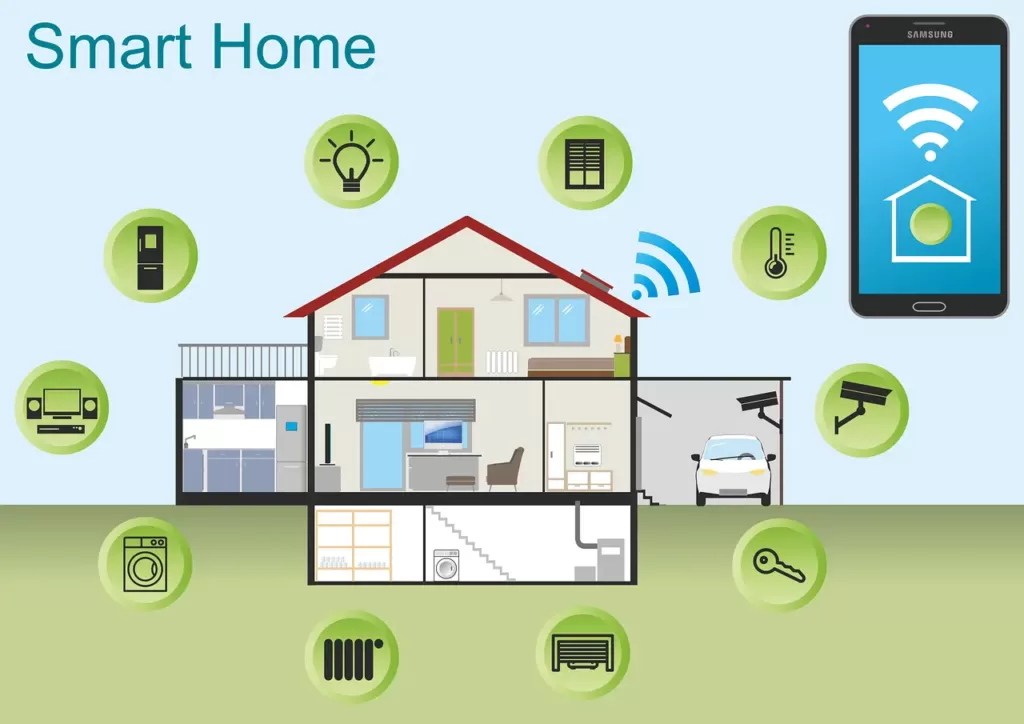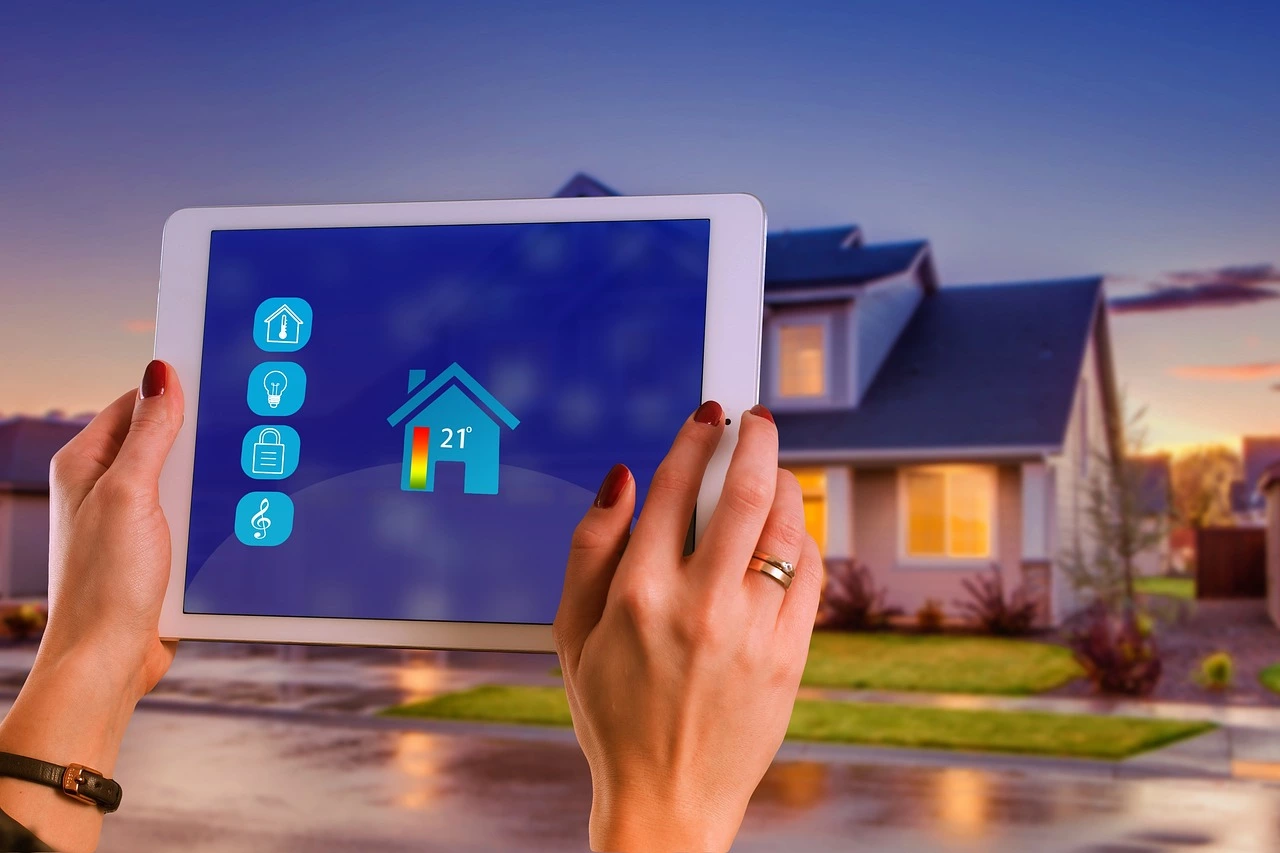Table of Contents
Introduction to Smart Homes

Image by Sabine Kroschel from Pixabay
Advanced technologies that enable the automation, control, and communication of numerous household systems and gadgets are found in houses considered “smart.” They use the Internet of Things capabilities to build a linked ecosystem in residential settings. The main goal of smart homes is to improve daily life’s comfort, convenience, and effectiveness by seamlessly integrating technology into our living spaces. Smart homes are designed to simplify and streamline our everyday lives by automating repetitive processes and offering centralized control.
Modern living has made technology a necessary component, and its incorporation into residential areas has changed how we interact with our houses. Intelligent algorithms, communication protocols, sensors, actuators, and other modern technology are all used in smart houses. These technologies enable automating and regulating many different features, including lighting, HVAC systems, security systems, entertainment systems, and even appliances.
Homes may now be controlled and monitored remotely thanks to the seamless network of devices made possible by integrating technology into residential areas. People may control and interact with their smart homes from anywhere via smartphones, tablets, or voice assistants, offering unmatched ease and flexibility. Technology integration gives residential living a new degree of control and accessibility, from setting the thermostat while away to getting alerts about potential security breaches.
Smart Home Infrastructure
Internet of Things and its Role in smart homes
Using sensors, software, and networking, IoT connects physical things, enabling seamless integration in smart homes and other systems. Smart thermostats are made possible by IoT, which enables intelligent automation and management of appliances, lights, security cameras, and thermostats.
Centralized control systems and automation
By serving as a central hub, these systems let users manage and control numerous devices and systems via a single user interface. Homeowners may easily access and control their smart home components using their smartphones, tablets, or specialized control panels.
A crucial function made possible by centralized control systems is automation. Users may set up rules and schedules to control how various systems and devices behave automatically when certain circumstances are met. Homeowners may, for instance, set the lighting system to switch on and off at predetermined intervals or adjust the blinds based on the amount of natural light.
Connectivity and network requirements
The correct operation of smart homes depends on a strong and dependable network infrastructure. Data interchange between devices is made possible by high-speed internet access, enabling real-time monitoring and control. A strong and safe home network guarantees that gadgets can interact easily and react quickly to user requests.
Smart homes can need a mix of wired and wireless connectivity to accommodate various systems and gadgets. For devices that require a continual connection, such as security cameras or smart hubs, Ethernet connections offer robust and dependable communication. Smart speakers, smart thermostats, and other devices that need mobility or placement flexibility frequently employ wireless protocols like Wi-Fi, Bluetooth, or Zigbee.
Security Considerations for smart homes
Security issues are essential as smart homes grow more linked. There is a chance for cyber attacks and illegal access because so many systems and gadgets are online. Protecting smart homes from security breaches requires strong measures like firewalls, authentication, encryption, and regular software updates and patches.
Using strong passwords, activating two-factor authentication, and being cautious when providing access rights to third-party apps or devices are other recommended practices that homeowners should adhere to.
Smart homes can offer homeowners peace of mind by putting security first, ensuring their data and privacy are safeguarded from potential threats.
Comfort Innovations in Smart Homes
Climate control and energy management
- Temperature control and smart thermostats The fundamental technological advancement in smart homes that enables homeowners to control and optimize the temperature in their living areas is the smart thermostat.
These gadgets employ sensors to detect occupancy and alter temperature settings accordingly to provide comfort while improving energy economy. Smart thermostats provide simplicity and versatility in regulating climate management since they can be operated remotely via smartphones or voice commands.
- Energy-efficient lights and appliances Energy-saving fixtures and appliances are included in smart homes to encourage sustainability and lower energy usage.
Smart appliances, like refrigerators and washers, use LED technology to efficiently operate and conserve energy, while smart lighting systems automatically dim or turn off when not in use.
- Integrate renewable energy sources into smart houses. Homeowners may regulate their energy output and usage by tying these renewable energy systems into their smart home infrastructure.
Thanks to this integration, homeowners may maximize renewable energy sources and lessen their reliance on conventional power systems.
Intelligent lighting and ambiance
- Lighting solutions that adjust Adaptive lighting systems are characteristic of smart homes that change brightness, color temperature, and even color schemes in accordance with human preferences or environmental circumstances.
These devices can replicate the day’s natural illumination cycles, fostering a more wholesome circadian rhythm. Adaptive lighting also improves ambiance by establishing distinct tenses or settings for various activities, such as unwinding, working, or entertaining.
- Scene and mood settings Homeowners with smart homes may designate and personalize predetermined mood or scene settings for various situations. The lighting, music, temperature, and other elements may be changed concurrently with a single command or button click to provide the appropriate environment.
For an immersive cinematic experience, the lights may be dimmed, the curtains drawn, and the home theater system turned on, as in a “movie night” scene.
- Optimization of natural light To maximize the advantages of daylight, smart houses use approaches for optimizing natural light. Artificial lighting can be modified in accordance with the direction and intensity of natural light as determined by sensors.
Delivering the ideal mix of natural and artificial illumination throughout the day, not only lowers energy consumption but also improves the general comfort and well-being of the inhabitants.
Entertainment and multimedia integration
- audio and video dissemination across the home Whole-home audio and video distribution systems are available in smart homes, allowing for seamless entertainment across the home.
These systems let users concurrently transmit audio or video material to several rooms or locations, resulting in a seamless audiovisual experience. The living room may be used to view a movie while background music is being played in the kitchen, and any other room in a smart house can be used for entertainment.
- Virtual assistants and voice recognition Voice control capabilities and virtual assistants like Amazon Alexa or Google Assistant are integrated into smart homes.
Thanks to this, users may utilize voice commands to operate various entertainment systems and devices. Without the need for remote controls or direct physical connection, homeowners may alter the level, change the channel, or even request specific material, making their entertainment experience more convenient and simple.
- Home movies and immersive activities High-quality audio and video systems may be incorporated into smart homes to produce immersive home theater experiences. These systems, which have surround sound speakers and large high-definition displays, provide an immersive film experience in the convenience of one’s home.
Other components, like lighting and drapes, may also be coordinated by smart home automation to improve the atmosphere and submerge consumers in a completely immersive entertainment experience.
Conclusion
Innovative technologies that improve comfort and efficiency are being incorporated into smart homes, altering how we live. Thanks to these interconnected ecosystems created using the Internet of Things (IoT), users may control several parts of their houses from a single interface. Comfort advances include climate control, energy management, intelligent lighting, entertainment, and multimedia integration.
But, security concerns must come first, and AI and machine learning will further improve automation and personalization. Integration with wearable technology and health monitoring also increases security and well-being. For the unique requirements of the elderly and the disabled, smart home automation will be available, promoting independence and raising the standard of living.

